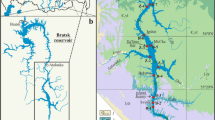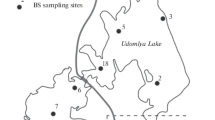Abstract
Sediment cores were collected for pore-water analysis from the eastern end of Devils Lake, located in northeastern North Dakota, to determine diagenetic reactions occurring in surficial bottom sediments and to evaluate the impact of these reactions on chemical concentrations in the overlying lake water. Sediment pore waters are enriched in major ions and nutrients relative to lake water. The principal sources of major ions to pore water are saline sediments located in the upper 1 m of bottom sediment. The principal source of titration alkalinity and nutrients to pore water is microbial decomposition of sedimentary organic matter by sulfate reduction. Sediment pore waters in the eastern part of Devils Lake have higher major-ion concentrations and solute-flux rates than the sediment pore waters in the central part of the lake. In contrast, sediment pore waters in the central part of Devils Lake have significantly higher nutrient concentrations and solute-flux rates. Major-ion concentrations and solute-flux rates in sediment pore water increase from west to east. These trends indicate that bottom-sediment diagenetic processes are, in part, responsible for the observed concentration gradient in the lake. The higher nutrient concentrations and the higher nutrient diffusional-flux rates in Main Bay are the result of more labile sedimentary organic matter and the occurrence of sulfate reduction. Environmentally-reactive trace-metal concentrations (Cu, Pb, Zn, and Fe) in bottom sediments decrease from west to east with distance from the surface-water sources and with increasing surface-water salinity.
Similar content being viewed by others
References
Appelby, P.G. and Oldfield, F. 1978. The calculation of lead-210 dates assuming a constant rate of supply of unsupported 210Pb to the sediment. Cantena 5: 1–8.
Armstrong, R., Anderson, D.W. and Callender, E. 1966. Primary productivity measurements at Devils Lake, North Dakota. North Dakota Academy of Science Annual Proceedings, pp. 137–149.
Ball, J.W. and Nordstrom, D.K. 1987. WATEQ4F-a personal computer FORTRAN translation of the geochemical model WATEQ2 with revised data. U.S. Geological Survey Open-File Report 87-50.
Barton, C.E., Solomon, D.K., Bowman, J.R., Cerling, T.E. and Sayer, M.D. 1987. Chloride budgets in transient lakes: Lakes Baringo, Naivasha and Turkana. Limnology and Oceanography 32: 745–751.
Berner, R.A. 1980. Early Diagenesis, A Theoretical Approach. Princeton University Press, Princeton, NJ.
Bray, J.T. 1973. The behavior of phosphate in the interstial waters of Chesapeake Bay sediments. Ph.D. Dissertation, The Johns Hopkins University, Baltimore, MD.
Callender, E. 1968. The post glacial sedimentology of Devils Lake, North Dakota. Ph.D. thesis, University of North Dakota.
Callender, E. and Hammond, D.E. 1982. Nutrient exchangeacross the sediment-water interface in the Potomac River estuary. Estuarine, Coastal and Shelf Science 15: 395–413.
Carmody, D.J., Pearce, J.B. and Yasso, W.E. 1973. Trace metals in sediments of New York Bight. Marine Pollution Bulletin 14: 225–235.
Cerling, T.E. 1986. A mass-balance approach to basin sedimentation: Contraints on the recent history of the Turkana basin. Palaeogeography, Palaeoclimatology, Palaeoecology 54: 63–88.
Cutshall, N.H., Larsen, I.L. and Olsen, L.R. 1983. Direct analysis of 210Pb in sediment samples: self-adsorption corrections. Nuclear Instruments and Methods 206: 309–312.
Dean, W.E. and Gorham, E. 1976. Major chemical and mineral components of profundal surface sediments in Minnesota lakes. Limnology and Oceanography 21: 259–284.
Drever, J.I. 1988. The Geochemistry of Natural Waters. 2nd Edition. Prentice Hall, New York.
Eugster, H.P. and Hardie, L.A. 1978. Saline lakes. In: A. Lerman (Ed.) Lakes: Chemistry, Geology, and Physics, pp. 237–293. Spring-Verlag, New York.
Eugster, H.P. and Jones, B.F. 1979. Behavior of major solutes during closed-basin brine evolution. American Journal of Science 279: 609–631.
Fritz, S.C. 1990. Twentieth-century salinity and water-level fluctuations in Devils Lake, North Dakota: test of s diatom-based transfer function. Limnology and Oceanography 35: 1771–1781.
Gaillard, J.F., Sarazin, G., Pauwells, H., Phillipe, L., Lavergne, D. and Blake, G. 1987. Interstitial water and sediment chemistries of Lake Aiguebelette (Savoy, France). Chemical Geology 63: 73–84.
Gasseler, H., von Gunten, H.R. and Nyffeler, V. 1976. Determination of 210Pb in lake sediments and in air samples by direct gamma-ray measurements. Earth and Planetary Science Letters 33: 119–121.
Glibert, P.M. and Loder, T.C. 1977. Automated analysis of nutrients in seawater, a manual of techniques. WHOI Technical Report Number 77-47, Woods Hole, MA.
Hobbs, H.C. and Bluemle, J.P. 1987. Geology of Ramsey County, North Dakota Geological Survey Bulletin 71.
Jacobson, H.A. and Engstrom, D.R. 1989. Resolving the chronology of recent lake sediments: an example from Devils Lake, North Dakota. Journal of Paleolimnology 2: 81–97.
Komor, S.C. 1992. Bidirectional sulfate diffusion in saline-lake sediments: evidence from Devils Lake, northeast Dakota. Geology 20: 319–322.
Komor, S.C. 1994. Bottom-sediment chemistry in Devils Lake, northeast North Dakota. In: R.W. Renaut, and W.M. Last (Eds.) Sedimentology and Geochemistry of Modern and Ancient Saline Lakes: Society of Environmental Petrologists and Mineralogists Special Publication 50, pp. 21–32.
Krom, M.D. and Berner, R.A. 1980. The diffusion coefficients of sulfate, ammonium, and phosphate ions in anoxic marine sediments. Limnology and Oceanography 25: 327–337.
Lent, R.M., Lyons, W.M., Showers, W.J. and Johannesson, K.H. In press. Late Holocene paleoclimatic and palebiologic records from sediments of Devils Lake, North Dakota, Journal of Paleolimnology.
Lerman, A. 1979. Geochemical Processes, Water and Sediment. Wiley, New York.
Lerman, A. and Jones, B.F. 1973. Transient and steady-state salt transport between sediments and brine in closed lakes. Limnology and Oceanography 18: 72–85.
Li, Y.H. and Gregory, S. 1974. Diffusion of ions in sea water and in deep-sea sediments. Geochemica et Cosmochemica Acta 38: 703–714.
Lyons, W.B., Armstrong, P.B. and Gaudette, H.E. 1983. Trace metal concentrations and fluxes in Bermuda sediments. Marine Pollution Bulletin 14: 65–68.
Lyons, W.B. and Fitzgerald, W.f. 1980. Trace metal fluxes to nearshore Long Island Sound sediments. Marine Pollution Bulletin 11: 157–161.
Lyons, W.B., Spencer, M.J., Hines, M.E. and Gaudette, H.E. 1988. Trace metal geochemistry of pore water brines from two hypersaline lakes. Geochemica et Cosmochemica Acta 52: 265–274.
Martens, C.S., Berner, R.A. and Rosenfeld, J.K. 1978. Interstitial water chemistry of anoxic Long Island Sound sediments II. Nutrient regeneration and phosphate removal. Limnology and Oceanography 23: 205–217.
Murray, J.W. and Gill, G. 1978. The geochemistry of iron in Puget Sound, Washington, Geochemica et Cosmochemica Acta 42: 9–20.
Sether, B.A. and Wiche, G.J. 1989. Meterologic and hydrologic data collected for computing evaporation from Devils Lake, North Dakota, 1986–88. North Dakota State Water Comm., Water-Resources Investigation 10.
Sholkovitz, E. 1973. Interstitial water chemistry of the Sante Barbara basin sediments. Geochemica et Cosmochemica Acta 37: 2043–2074.
Stoermer, E.F., Taylor, S.M. and Callender, E. 1971. Paleoecological interpretation of the Holocene diatom succession in Devils Lake, North Dakota. Transaction of the American Microscopical Society, 90, pp. 195–206.
Wiche, G.J. 1992. Hydrology and water-level fluctuations of Devils Lake, North Dakota-Selected Papers in the Hydrologic Sciences 1988–92. U.S. Geological Survey Water-Supply Paper 2340, pp. 75–87.
Author information
Authors and Affiliations
Rights and permissions
About this article
Cite this article
Lent, R.M., Lyons, W.B. Porewater geochemistry and solute flux from bottom sediments, Devils Lake, North Dakota. International Journal of Salt Lake Research 3, 113–135 (1994). https://doi.org/10.1007/BF01990490
Issue Date:
DOI: https://doi.org/10.1007/BF01990490




